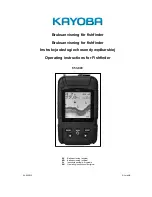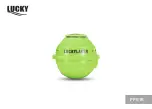
APPENDIX 2 INSTALLATION FOR TRANSDUCER (THRU-HULL MOUNT)
AP-5
Hull Types
(see Figure 3)
• The water flowing under the hull must be smooth with a
minimum of bubbles and turbulence (especially at high
speeds).
•
The transducer must be continuously immersed in water.
• The transducer beam must be unobstructed by the keel or
propeller shaft(s).
•
Choose a location away from interference caused by power
and radiation sources such as: the propeller(s) and shaft(s),
other machinery, other echosounders, and other cables.
The lower the noise level, the higher the echosounder gain
setting that can be used.
•
CHIRP transducer
- Mount in a cool well-ventilated area
away from the engine to avoid overheating.
Installation
1. Drill a 3 mm or 1/8" pilot hole from inside the hull. If there is
a rib, strut, or other hull irregularity near the selected
mounting location, drill from the outside.
2. Using the appropriate size outside hull hole saw, cut a hole
from outside of the hull perpendicular to the hull surface
(see table above).
SS565
-
Use a countersink tool to create a “seat” in the
hull.
3. Sand and clean the area around the hole, inside and
outside, to ensure that the sealant will adhere properly to
the hull. If there is any petroleum residue inside the hull,
remove it with either mild household detergent or a weak
solvent (alcohol) before sanding.
Metal hull
-
Remove all burrs with a file and sandpaper.
Figure 3. Best location for transducer
Copyright © 2005 Airmar Technology Corp.
Identify Your Model
The model name is printed on the cable tag.
Model
(Housing)
Hull
Material
Outside Hull
Hole Saw Size
Cored Fiberglass Hull
Hull Interior
Hole Saw Size
P19
Fiberglass
metal
51 mm or 2"
60 mm or 2-3/8"
B150M
B619
SS150M
SS619
Fiberglass
wood
51 mm or 2"
60 mm or 2-3/8"
SS150M
SS619
Metal
57 mm or 2-1/4"
NA
B60
SS60
SS56
Fiberglass
wood
60 mm or 2-3/8"
80 mm or 3-1/8"
B75H/M/L Fiberglass
wood
70 mm or 2-3/4"
80 mm or 3-1/8"
SS60
SS565
Metal
70 mm or 2-3/4"
NA
Tools & Materials
Safety goggles
Dust mask
Angle finder
Electric drill with 10 mm (3/8") or larger chuck capacity
Drill bit: 3 mm or 1/8"
Hole saw (see table above)
Countersink tool (installing SS565)
Sandpaper
Mild household detergent or weak solvent (such as alcohol)
File (installation in a metal hull)
Marine sealant (suitable for below waterline)
Slip-joint pliers (installing a metal housing)
Grommet(s) (some installations)
Cable ties
Water-based anti-fouling paint (
mandatory in salt water
)
Installation in a cored fiberglass hull (see page AP-7):
Hole saw for hull interior (see table above)
Fiberglass cloth and resin
or Cylinder, wax, tape, and casting epoxy
Large displacement hulls
Small displacement hulls
Planing hulls
Outboard and I/O
Stepped hull
Mounting Location
CAUTION
: Do not mount near water intake or discharge
openings or behind strakes, fittings, or other hull irregularities.
CAUTION
: Do not mount in line with trailer rollers or bunks
that may damage the transducer’s face.
•
Displacement hull powerboats
- Locate amidships near
the centerline. The starboard side of the hull where the
propeller blades are moving downward is preferred.
•
Planing hull powerboats
- Mount well aft, on or near the
centerline, and well inboard of the first set of lifting strakes
to ensure that the transducer will be in contact with the
water at high speeds. The starboard side of the hull where
the propeller blades are moving downward is preferred.
Outboard and I/O
- Mount just forward of the engine(s).
Inboard
- Mount well ahead of the propeller(s) and shaft(s).
Stepped hull
- Mount just ahead of the first step.
Boat capable of speeds above 25 kn
(29 MPH) - Review
the installation location and operating results of similar
boats before proceeding.
•
Fin keel sailboats
- Mount on or near the centerline and
forward of the fin keel 300 - 600 mm (1 - 2').
•
Full keel sailboats
- Locate amidships and away from the
keel.
Hole Drilling
Cored fiberglass hull
- Follow separate instructions on page
AP-7.
Bedding
CAUTION
: Be sure the surfaces to be bedded are clean and
dry.
Apply a 2 mm (1/16") thick layer of marine sealant around the
flange of the housing that contacts the hull and up the
sidewall of the housing (see Figure 4 or 5). The sealant must
extend 6 mm (1/4") higher than the combined thickness of the
hull, washer(s), hull nut, and any spacer. This will ensure
there is marine sealant in the threads to seal the hull and to
hold the hull nut securely in place.
Fin keel sailboats
Full keel sailboats
Summary of Contents for FCV-587
Page 1: ......
Page 73: ...7 Nov 2013 H MAKI D 1...
Page 74: ...18 Nov 2013 H MAKI D 2...
Page 75: ...D 3 13 Jan 2012 Y NISHIYAMA...
Page 76: ...D 4 13 Jan 2012 Y NISHIYAMA...
Page 77: ...D 5 12 Mar 2015 H MAKI...
Page 82: ......
Page 83: ......

































